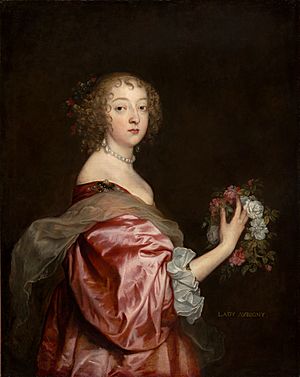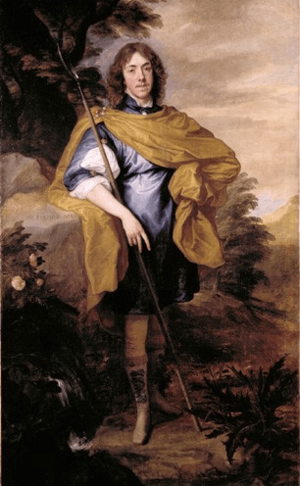Katherine Stuart facts for kids
Quick facts for kids
Katherine Stuart
|
|
|---|---|

Portrait by Van Dyck, circa 1638. National Gallery of Art, Washington DC
|
|
| Died | 1650 |
| Other names | Katherine Howard Katherine, Lady Aubigny Katherine Livingston, Viscountess Newburgh |
| Occupation | English noblewoman and Royalist supporter |
| Spouse(s) | George Stewart, 9th Seigneur d'Aubigny (1638–1642) James Livingston, Viscount Newburgh (1648–1650) |
| Children | 1) Charles Stewart, 3rd Duke of Richmond 2) Katherine Stewart, Baroness Clifton 3) Elizabeth Livingstone |
| Parent(s) | Theophilus Howard, 2nd Earl of Suffolk Lady Elizabeth Home |
Katherine Stuart (died 1650) was a brave English noblewoman. She strongly supported the King during the English Civil War. This was a big fight between the King and Parliament.
Katherine secretly married her first husband, George Stewart, 9th Seigneur d'Aubigny. This was against the wishes of King Charles I and her own parents. George was a commander for the King's army. He sadly died in battle in 1642.
Later, Katherine used a trip to London to help the Royalists. She secretly passed messages to them. When she was found out, she was put in the Tower of London. Luckily, the French ambassador helped her get released.
In 1648, Katherine married James Livingston. They tried to help the King escape from Parliament. After the King was executed, Katherine and James had to leave England. They went to the Netherlands, where Katherine died in 1650.
Contents
Katherine's Early Life and Secret Wedding
Katherine Stuart was born Katherine Howard. Her parents were Theophilus Howard, 2nd Earl of Suffolk, and Lady Elizabeth Home. In May 1638, Katherine did something very daring. She secretly married George Stewart, 9th Seigneur d'Aubigny.
This marriage went against her parents' wishes. It also went against King Charles I's plans. The King was George's guardian, like a protector. A famous painting by Van Dyck shows George. It has a motto that means "love is stronger than I am." Katherine and George had two children. Their son was Charles Stewart, 3rd Duke of Richmond (born 1639). Their daughter was Katherine Stewart, Baroness Clifton.
Helping the King in the First English Civil War
The First English Civil War began in August 1642. George, Katherine's husband, fought for the King. He was a cavalry commander. Sadly, he was killed in the Battle of Edgehill on October 23, 1642.
After George died, Katherine joined King Charles's court in Oxford. In May 1643, she got permission to go to London. She said she needed to sort out her husband's affairs. But she used this trip to secretly send messages from the King. These messages went to people in London who supported the King. This secret plan was called the Waller plot. King Charles even received so many coded letters from Katherine that he said it would take a whole day to read them!
The Waller Plot failed. Katherine was arrested and sent to the Tower of London. Some of the other people involved were punished severely. But Katherine was clever. She arranged her release through the French ambassador. This was because her husband had French titles. By May 1645, Katherine was in Bristol. She wanted to get back into the King's good graces.
The Second English Civil War and a New Marriage
In 1647, Katherine received important rights over her late husband's property. This might have been thanks to her brother, James Howard, 3rd Earl of Suffolk. The Second English Civil War started in February 1648. Later that year, Katherine married James Livingston, Viscount Newburgh.
By this time, the King was being held prisoner by Parliament. In December 1648, the King stayed at Katherine and James's house in Bagshot, Surrey. He was on his way to his trial. Katherine and her husband tried to help the King escape. But their plan was stopped by Major General Thomas Harrison. Even so, they managed to pass messages from King Charles to his wife, Henrietta Maria of France.
Katherine's Final Years
After the King was executed, Katherine and her husband had to leave England. They fled to The Hague in the Netherlands, along with other Royalists. Katherine and James had a daughter named Elizabeth. Katherine died in 1650.
Her death was a big loss for the Royalists. A famous historian, Edward Hyde, 1st Earl of Clarendon, wrote about her. He said she was "a woman of a very great wit." He also said she was very trusted in the secret plans that ladies could best manage. After the King was restored to the throne in 1660, James was made Earl of Newburgh.


